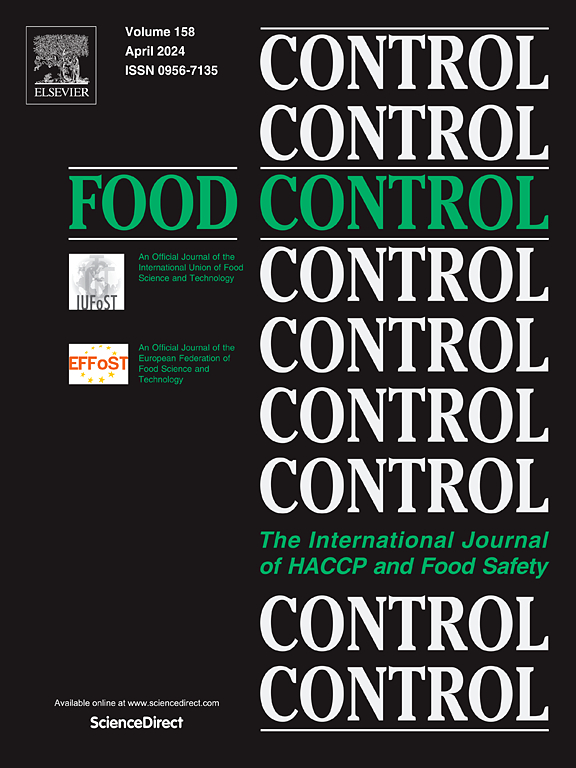评估食品生产中的手卫生:闭路电视监控的可行性
IF 5.6
1区 农林科学
Q1 FOOD SCIENCE & TECHNOLOGY
引用次数: 0
摘要
在食品和饮料制造企业中,安装闭路电视(CCTV)系统进行监控是很常见的。尽管闭路电视被广泛用于安全,但有人建议闭路电视可以帮助评估食品处理人员的做法,例如手卫生合规。本研究旨在探讨利用闭路电视进行隐蔽观察评估手卫生依从性的可行性。与制造企业(n = 11)的技术负责人(n = 21)进行面对面访谈,探讨了闭路电视的使用和好处,并调查了利用闭路电视评估手部卫生依从性的看法。尽管闭路电视系统在食品生产中很常见,但调查结果表明,它们很少用于观察手部卫生习惯。安装摄影机主要是为了阻吓罪案,或在发生意外、意外或调查投诉时使用。企业报告说,缺乏专门的资源和时间来使用闭路电视系统进行定期的结构化观察,以建立合规性。使用电子观察检查表审查来自制造商(n = 3)的闭路电视录像(53h),包括852次手部卫生尝试,以确定合规性。调查结果表明,尽管大多数(88%)食品处理人员试图在进入食品生产区之前实施手卫生措施,但几乎所有的尝试(98%)都不符合手卫生规程。本研究的结论是,闭路电视系统的广泛使用,在整个食品生产设施中提供了多个有利位置,可以对食品处理人员的行为进行不显眼的观察。该研究确定了使用隐蔽观察来评估食品制造企业手卫生合规性的可行性,以确定需要进一步直接补救或干预的做法。本文章由计算机程序翻译,如有差异,请以英文原文为准。
Assessing hand hygiene in food manufacturing: The feasibility of CCTV surveillance
Installation of closed-circuit television (CCTV) systems for surveillance is common in food and drink manufacturing businesses. Despite widespread use for security, it is suggested CCTV could assist in assessing food handler practices, such as hand hygiene compliance. This study aimed to explore the feasibility of using CCTV for covert observation to assess hand hygiene compliance. Face-to-face interviews with technical leaders (n = 21) from manufacturing businesses (n = 11) explored the use and benefits of CCTV and investigated perceptions regarding utilising CCTV to assess hand hygiene compliance. Although CCTV systems are common in food manufacturing, findings indicated they were seldom used to observe hand hygiene practices. Cameras were predominantly installed as a crime deterrent or used in the event of incidents, accidents or complaint investigations. Businesses reported a lack of dedicated resources and time to conduct regular structured observations using CCTV systems to establish compliance. CCTV footage (53h) from manufacturers (n = 3) including 852 hand hygiene attempts was reviewed using an electronic observational checklist to determine compliance. Findings indicated that although the majority (88%) of food handlers attempted to implement hand hygiene practices prior to entering food production areas, almost all attempts (98%) were non-compliant with hand hygiene protocols. This study concludes that the widespread use of CCTV systems, providing multiple vantage points throughout food manufacturing facilities, allows for unobtrusive observation of food handler behaviours. The study has determined the feasibility of using covert observation to assess hand hygiene compliance in food manufacturing businesses to identify practices that require further direct remediation or intervention.
求助全文
通过发布文献求助,成功后即可免费获取论文全文。
去求助
来源期刊

Food Control
工程技术-食品科技
CiteScore
12.20
自引率
6.70%
发文量
758
审稿时长
33 days
期刊介绍:
Food Control is an international journal that provides essential information for those involved in food safety and process control.
Food Control covers the below areas that relate to food process control or to food safety of human foods:
• Microbial food safety and antimicrobial systems
• Mycotoxins
• Hazard analysis, HACCP and food safety objectives
• Risk assessment, including microbial and chemical hazards
• Quality assurance
• Good manufacturing practices
• Food process systems design and control
• Food Packaging technology and materials in contact with foods
• Rapid methods of analysis and detection, including sensor technology
• Codes of practice, legislation and international harmonization
• Consumer issues
• Education, training and research needs.
The scope of Food Control is comprehensive and includes original research papers, authoritative reviews, short communications, comment articles that report on new developments in food control, and position papers.
 求助内容:
求助内容: 应助结果提醒方式:
应助结果提醒方式:


